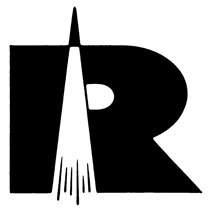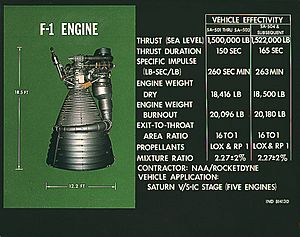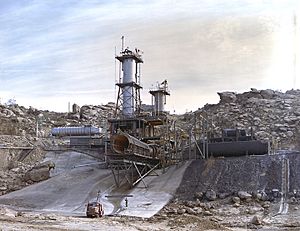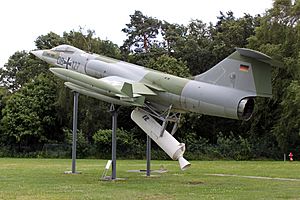Rocketdyne facts for kids
 |
|
| Industry | Rocket engines |
|---|---|
| Fate | Acquired |
| Successor |
|
| Founded | 1955 |
| Defunct | 2005 |
| Headquarters |
,
United States
|
|
Key people
|
|
| Parent |
|
Rocketdyne was an American company that designed and built rocket engines. Its main office was in Canoga Park, a part of Los Angeles in southern California.
The company started as a part of North American Aviation (NAA) in 1955. Later, it became part of Rockwell International (from 1967 to 1996) and then Boeing (from 1996 to 2005). In 2005, Rocketdyne was sold to United Technologies Corporation. It was then called Pratt & Whitney Rocketdyne. In 2013, it was sold again to GenCorp, which combined it with Aerojet to create Aerojet Rocketdyne.
Contents
History of Rocketdyne
After World War II, the U.S. government asked North American Aviation (NAA) to study the German V-2 missile. They wanted to update its engine for American use. NAA also used ideas from the V-2 engine to build a much bigger engine for the Navaho missile project. This work began around 1946.
In the 1940s, this work was not seen as very important. But when the Korean War started in 1950, things changed. NAA began testing its rocket engines at the Santa Susana Field Laboratory (SSFL) around 1947. This site was far from cities, which was good for testing rockets.
The Navaho missile project had many problems and was stopped in 1958. However, the Rocketdyne engine for Navaho, called the A-5, was very reliable. So, another missile, the Redstone, was updated to use the A-5 engine.
As more missiles were made, NAA made Rocketdyne a separate company division in 1955. They built a new factory in Canoga Park, close to the Santa Susana Field Laboratory. In 1967, NAA and Rocketdyne joined with the Rockwell Corporation. This new company was called North American Rockwell, and later Rockwell International in 1973.
Rockets for Space and Defense
Rocketdyne's next big engine was the S-3D. This engine was used on the Army's Jupiter missile. It was also chosen for the Air Force's Thor missile. A larger engine, the LR89/LR105, was used on the Atlas missile.
The Thor missile was not used by the military for long. But it became important for launching satellites into space in the 1950s and 60s. One version, the Thor Delta, led to today's Delta rockets. Even though the Delta rockets have changed a lot, they still use an updated version of Rocketdyne's S-3 engine, called the RS-27.
The Atlas missile also had a short military life. But the Atlas rocket family became a very important launcher for many years. It launched the first American astronauts in Project Mercury. It was also used for the Atlas-Agena and Atlas-Centaur rockets. The Atlas V rocket is still made and used today.
Working with NASA
Rocketdyne became the main supplier of engines for NASA's space programs. They built all the major engines for the Saturn rockets. The H-1 engine was used on the Saturn I rocket. Five huge F-1 engines powered the first stage of the Saturn V rocket. Five J-2 engines powered its second stage, and one J-2 engine powered its third stage.
By 1965, Rocketdyne made most of the rocket engines in the United States. Only the Titan rocket engines were made by another company, Aerojet. Rocketdyne had grown to 65,000 employees. This growth continued when Rocketdyne won the contract for the RS-25 Space Shuttle Main Engine (SSME). However, other military and civilian contracts decreased, leading to the company getting smaller.
Rocketdyne's Locations
Rocketdyne had several important locations where they designed, built, and tested rocket engines.
Canoga Park, California
Rocketdyne's main office and factory were in Canoga Park from 1955 until 2014. North American Aviation started testing rocket engines near Los Angeles Airport. In 1948, they began testing liquid rocket engines in the Simi Hills. This area later became the Santa Susana Field Laboratory. The company wanted a factory close to this test site.
In 1954, North American Aviation bought land in what is now Warner Center. They gave this land to the Air Force. The Air Force called it Air Force Plant No. 56 and hired Rocketdyne to build and run the factory. The main factory building was finished in November 1955.
Rocketdyne grew a lot, adding more buildings. At its biggest, the Canoga plant had about 27 buildings over 119 acres. It had over a million square feet for manufacturing and lots of office space. The plant grew to the east and southeast of its first location. In 1960, Rocketdyne opened a main office building.
Over time, the Canoga plant became smaller as parts of the property were sold. After the Apollo program ended in 1969, Rocketdyne gave up some of its leases. In 1973, Rocketdyne bought the Air Force Plant No. 56 property, ending its government status. The Space Shuttle program ended in 2011, leading to more reductions.
Rocketdyne played a very important role in the United States space program. Ten years after it started, the Canoga plant made most of America's liquid rocket engines. Rocketdyne's products powered all the major engines for the Saturn program and every U.S. space program through the end of the 20th century.
Key rocket engine technologies were developed at the Canoga plant. These included ways to steer rocket engines, improve how fuel burns, and cool engines.
Aerojet Rocketdyne moved its operations in 2014. The old Rocketdyne factory in Canoga Park was torn down starting in 2016.
McGregor, Texas
Rocketdyne also had a business unit in McGregor, Texas, for nearly 20 years. This unit worked on solid rocket engines. In 1958, Rocketdyne partnered with Phillips Petroleum Company to form Astrodyne Incorporated. In 1959, Rocketdyne bought Astrodyne and renamed it Solid Propulsion Operations.
This group made solid rocket boosters for aircraft. For example, they made motors that helped the Lockheed F-104 Starfighter aircraft take off very quickly without a runway. This motor gave 130,000 pounds of thrust for 4 seconds.
For 19 years, Rocketdyne used a special mix called "Flexadyne" to make solid rocket motors. These motors were used in three major missile systems: the AIM-7 Sparrow III, AGM-45 Shrike, and the AIM-54 Phoenix. Rocketdyne transferred the McGregor plant to Hercules Inc. in 1978. Today, part of this site is used by SpaceX for rocket development and testing.
Neosho, Missouri
Rocketdyne also ran a rocket engine factory in Neosho, Missouri, for 12 years. The U.S. Air Force built this plant. Rocketdyne operated it starting in 1956, employing about 1,250 workers. The plant mainly made MA-5 engines, H-1 engines, and parts for the F-1 and J-2 rocket engines. Rocketdyne closed this plant in 1968.
Company Changes
During the 1980s and 1990s, Rockwell International sold off many parts of its company. The aerospace parts, including Rocketdyne, were sold to Boeing in 1996. Rocketdyne then became part of Boeing's Defense division.
In 2005, Boeing agreed to sell "Rocketdyne Propulsion & Power" to Pratt & Whitney. This deal was completed on August 2, 2005. Boeing kept the Santa Susana Field Lab.
GenCorp bought Pratt & Whitney Rocketdyne in 2013 from United Technologies Corporation. They combined it with Aerojet to form Aerojet Rocketdyne.
Power Generation Systems
Besides building rocket engines, Rocketdyne also developed systems to create and control power. These included early nuclear power experiments, radioisotope thermoelectric generators (RTG), and solar power equipment. They even built the main power system for the International Space Station.
When Boeing sold Rocketdyne to Pratt & Whitney, the Power Systems part of Rocketdyne went to Hamilton Sundstrand, another company owned by United Technologies Corporation.
List of Rocketdyne Engines

Here are some of the rocket engines developed by Rocketdyne:
- Rocketdyne A1 to A6: Used on the Redstone missile.
- Rocketdyne A7: Used on the Jupiter C rocket.
- Rocketdyne LR79 family (including H-1, RS-27): Used on Thor, Delta, and Saturn I rockets.
- Rocketdyne LR-101 Vernier engine: A small engine used by Atlas, Thor, and Delta rockets for steering.
- Rocketdyne LR105 family: Used on Atlas rockets.
- Rocketdyne S-3D: Used on the PGM-19 Jupiter and PGM-17 Thor missiles.
- Rocketdyne F-1: A very powerful engine used by the Saturn V rocket.
- Rocketdyne H-1: Used by the Saturn I and IB rockets.
- Rocketdyne J-2: Used by both the Saturn V and Saturn IB rockets.
- Rocketdyne RS-25 Space Shuttle Main Engine (SSME): The main engine for the Space Shuttle, also used on the Space Launch System.
- Rocketdyne RS-27A: Used by the Delta II/III and Atlas ICBM.
- Rocketdyne RS-56: Used by the Atlas II rocket's first stage.
- Rocketdyne RS-68: Used by the Delta IV rocket's first stage.
Gallery
-
F-1 rocket engine
















